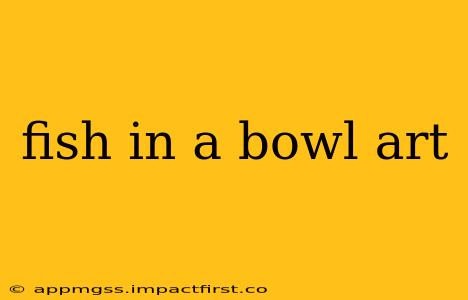Fish in a bowl art offers a surprisingly versatile and captivating subject for artists of all skill levels. From realistic depictions showcasing the shimmering scales and graceful movements of the fish, to stylized interpretations emphasizing color and form, the humble goldfish bowl provides a wealth of creative possibilities. This exploration delves into the artistic interpretations of this common motif, examining techniques, styles, and the enduring appeal of this seemingly simple subject.
What are some popular styles of fish in a bowl art?
The beauty of fish in a bowl art lies in its adaptability to various artistic styles. Realism is a popular choice, requiring meticulous attention to detail to capture the subtle iridescence of the scales and the gentle curves of the fish's body. Hyperrealism takes this further, aiming for a photographic level of accuracy. Conversely, impressionism allows for a looser, more expressive approach, focusing on capturing the overall mood and light rather than precise details. Abstract interpretations might focus on the shapes, colors, and movement of the fish, deconstructing the subject into a more symbolic representation. Even pop art can find a home in this theme, employing bold colors and graphic elements to create a vibrant and eye-catching piece.
What materials are commonly used to create fish in a bowl artwork?
The choice of materials significantly impacts the final aesthetic of the artwork. Painters might choose oils, acrylics, watercolors, or gouache, each offering unique textural and color possibilities. Sculptors might opt for clay, resin, or even glass to create three-dimensional representations of fish and bowls. Digital artists can explore a range of software and techniques to produce stunning, photorealistic or abstract images. Mixed media approaches are also increasingly common, combining different materials to create depth and texture. For example, a painting might incorporate collage elements or textured papers to add visual interest.
How can I learn to paint fish in a bowl?
Learning to paint fish in a bowl, regardless of your chosen medium, involves careful observation and practice. Begin by studying the form and movement of the fish. Pay close attention to the reflections and refractions of light on the water and the glass bowl. Numerous online tutorials and workshops offer guidance on techniques, from basic shading and color mixing to more advanced concepts like perspective and composition. Start with simpler compositions and gradually increase the complexity of your artwork. Experiment with different brushes, techniques, and color palettes to discover your unique style. Remember, practice makes perfect!
What are some tips for painting realistic fish in a bowl?
Achieving realism in fish in a bowl paintings requires a keen eye for detail and a mastery of light and shadow. Begin by sketching a precise outline of the bowl and the fish within. Pay close attention to the anatomy of the fish, ensuring accurate proportions and graceful curves. Use a limited palette to start, focusing on subtle variations in tone and color to create depth and dimension. Mastering techniques like glazing and layering can help you achieve a smooth, realistic finish. Observe how light refracts through the water and the glass, creating highlights and shadows that add to the overall realism.
What is the symbolism of fish in a bowl art?
While seemingly simple, fish in a bowl art can carry a multitude of symbolic meanings. The fish itself can represent freedom, spirituality, or even life's journey. The confinement of the bowl can symbolize limitations, captivity, or the delicate balance between freedom and constraint. The water represents emotion, fluidity, and the subconscious. The overall interpretation can be highly personal and subjective, depending on the artist's intent and the viewer's perspective. This opens up a vast realm for artistic interpretation and exploration, adding another layer to the appeal of this enduring motif.
Where can I find inspiration for fish in a bowl art?
Inspiration can be found everywhere! Start by observing real goldfish bowls – pay attention to the movement of the fish, the play of light on the water, and the overall composition. Explore existing artworks featuring fish in bowls – analyzing their techniques, styles, and overall effect. Look for inspiration in nature, photography, and even everyday objects. Experiment with different angles, perspectives, and lighting to discover unique and captivating compositions for your own artwork. The possibilities are endless!
This exploration into the world of "fish in a bowl art" highlights the creative potential within this seemingly simple subject. The versatility of style, the range of materials, and the rich symbolism combine to make it a rewarding and inspiring theme for artists of all levels. So, grab your brushes, pencils, or digital tablet, and let your creativity swim!
